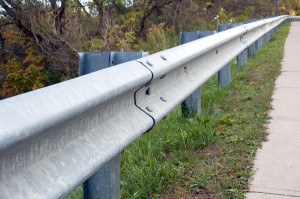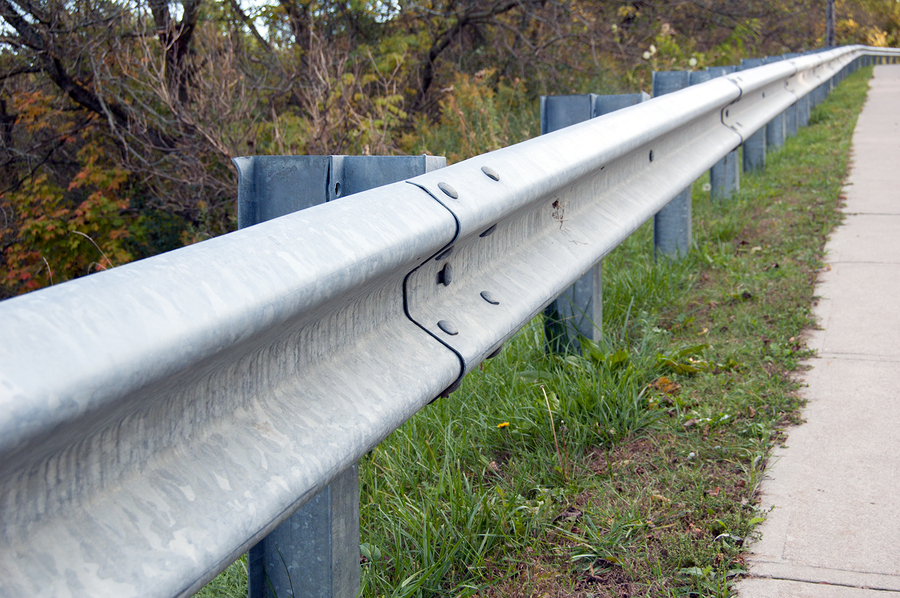Trinity Industries Inc.’s guardrail system, which has come under scrutiny for locking when hit and piercing cars instead of helping them slow, passed the first four of eight government-mandated crash tests, a federal highway agency said.
The Federal Highway Administration said on Friday that the devices used in the tests didn’t penetrate the vehicles or their occupant compartments. The final assessment of the system’s safety, which will include results from a second set of tests, will be released by the agency after it completes a review of the remaining crash data.
The crash-test results “validate” the company’s long- standing position that its ET-Plus guardrail system meets federal safety criteria, Jeff Eller, a spokesman for Trinity, said in an e-mail Friday. The devices tested account “for a vast majority of the ET-Plus Systems installed on highways nationwide,” he said.
The FHWA required Trinity to re-test the shock-absorbing safety system on Oct. 21, a day after a federal jury ruled in a false claims lawsuit that the company defrauded the U.S. by failing to disclose product changes made around 2005. The revisions went unreported to safety regulators for about seven years and, according to lawsuits, caused guardrails to malfunction. Plaintiffs have tied at least eight deaths to the ET-Plus.
Stopped Shipments
Trinity has stopped shipping the system, and at least 42 states and the District of Columbia suspended new installations pending a definitive evaluation of its safety.
Shares of Dallas-based Trinity rose as much as 2.5 percent on news of the test results.
They closed at $28.92 in New York Stock Exchange trading, up 1.7 percent for the day.
The agency’s ultimate finding on the series of tests will likely hinge on its analysis of the eighth one, which was “not unremarkable,” Suzi Emmerling, a spokeswoman for the Department of Transportation, said in a Feb. 5 phone interview. “We still have to look at the data to see if it passed,” she added.
An independent testing facility in San Antonio completed the crash tests on Jan. 27. The FHWA uses the data to help determine whether to approve highway safety hardware for use throughout the U.S. The agency’s sign-off on the ET-Plus, originally granted in 2000, opened up hundreds of millions of federal dollars to help states purchase the product. About 200,000 of them exist, the agency estimates.
Revoke Acceptance?
The FHWA has said it will revoke acceptance of the ET-Plus system if it doesn’t pass the current tests.
 The FHWA’s review of the first four tests found that the guardrails met U.S. requirements, including a mandate that the system “should not penetrate or show potential for penetrating the occupant compartment.” A third-party reviewer hired by the agency to analyze the results also said the guardrails passed, according to a separate report.
The FHWA’s review of the first four tests found that the guardrails met U.S. requirements, including a mandate that the system “should not penetrate or show potential for penetrating the occupant compartment.” A third-party reviewer hired by the agency to analyze the results also said the guardrails passed, according to a separate report.
During the eighth test, a small car was driven into the end of an ET-Plus system head-on at about 62 miles an hour, according to the FHWA-approved crash-test plan.
After the impact, the car spun around clockwise and came to a stop facing roughly the opposite direction, according to helicopter footage of the test taken by a TV station in San Antonio. The guardrail had bent onto itself, and the driver-side door was dented and pushed inward.
‘No Spearing’
“There was some deformation of the driver-side door, but there was no spearing or intrusion into the vehicle,” Tony Furst, the FHWA’s associate administrator for safety, said afterward. “Whether that is significant depends on the analysis of the crash test data.”
Brian Coon, a traffic engineer for the city of Wichita, Kansas, and a paid expert for the plaintiff in the false claims suit against Trinity, said in a Feb. 5 court document that the ET-Plus system failed the eighth test.
“The deformation of the driver’s side door in the Jan. 27 crash test not only could have caused disabling injuries, but showed a propensity to penetrate the vehicle,” he wrote in the filing. “This was a clear failure.”
A full analysis of the test data is still needed because a conclusion cannot be based “solely on visual representation,” Eller said in Trinity’s statement.
Third Version
Questions were raised about the testing process as it was under way, when two industry professionals involved in the false claims suit against Trinity told Bloomberg News there was a third ET-Plus version – with enlarged dimensions – that addressed the alleged spearing defect. If the third version was used in the current tests, the results may not fully address the safety concerns about the embattled second version, they said.
Test results made public Friday indicate that devices used in at least two of the first four tests had some dimensions bigger than those in the guardrails at issue in last year’s trial, according to the industry professionals, Joshua Harman and Dean Sicking. Even minor increases in dimensions may improve performance, they said. Harman filed the false claims suit against Trinity and Sicking was a paid consultant.
Trinity on Friday declined to comment on the dimensions of the tested guardrails. The company has said it informed regulators of all adjustments made to the ET-Plus since 2005, and that the tested product represents what is now on highways.
Reviewing Measurements
The FHWA has collected field measurements of more than 1,000 ET-Plus systems around the U.S., Emmerling said. The agency is reviewing the measurements and will determine whether there’s a third version of the ET-Plus.
The agency has said it may require further testing of the system or an evaluation of its field performance, and states may do their own analysis.
“Even if this thing gets flying colors tomorrow, how is it performing in this state?” Joe Jones, who oversees engineering policies for Missouri’s transportation department, said in an interview before the data were released. “We’re not going to be satisfied in this state until we’re sure this product doesn’t pose an elevated threat to drivers.”
Was this article valuable?
Here are more articles you may enjoy.


 ‘Super Roofs’ Are Rewarding Insurers, Cat Bond Investors and Homeowners
‘Super Roofs’ Are Rewarding Insurers, Cat Bond Investors and Homeowners  Zillow Deleting Climate Risk Scores Reveals Limits of Flood, Fire Data
Zillow Deleting Climate Risk Scores Reveals Limits of Flood, Fire Data  Standard Chartered Settles $2 Billion Iranian Sanction Suit in London
Standard Chartered Settles $2 Billion Iranian Sanction Suit in London  Truckers Who Fail English Tests Get Pulled Off Roads in Trump Crackdown
Truckers Who Fail English Tests Get Pulled Off Roads in Trump Crackdown 